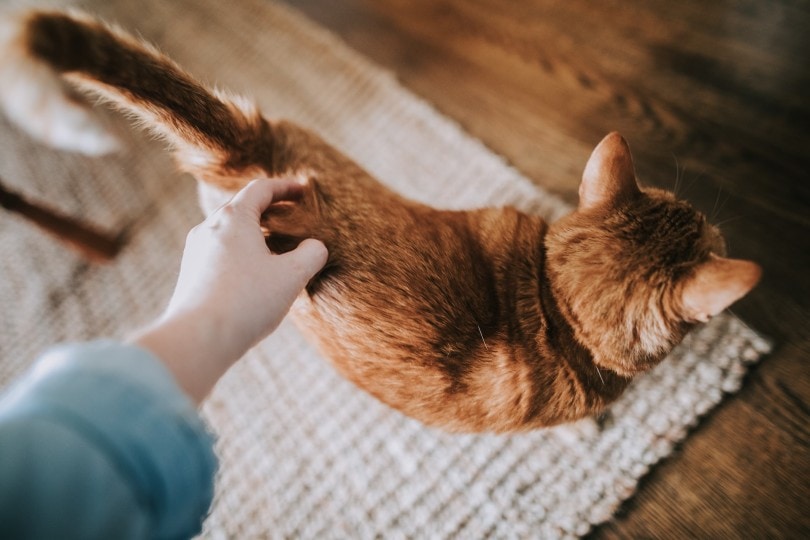If you have ever been petting your cat, you may have noticed that they lift their tail or bum in the air. There is a lot of confusion as to why cats do this and what the meaning behind the behavior is.
It is believed that cats will stick their bums and tails in the air as a positive response to being petted by their owners because they simply enjoy it. If you want to learn more about this quirky behavior in cats, then this article has all the answers you need!
The 4 Reasons Why Cats Lift Their Tails When You Pet Them
There are several reasons your cat might lift their tail or bum into the air when petted. This can also be referred to as “elevator butt” and it is common for both male and female cats to display if they are being petted in certain areas by their owners.
1. You Remind Your Cat of Being a Kitten
Cats may raise their tails and bum because they picked up this behavior from kittenhood. Over time, your cat will learn to trust you and might even feel as if you are an authority figure in their life, like a protector and provider because you shelter them and provide them with food and water—much like a mother cat would to her kittens.
Mother cats will help to groom the back of their kittens. So, if you are scratching your cat’s back, they most likely picked up the elevated bum and tail habit from when they were kittens.

Christin Hume, Unsplash
2. A Female Cat Is in Heat
Unspayed female cats will go into heat once they reach sexual maturity and are ready to mate. The heat cycle can repeat itself every 2–3 weeks, and during the late stages of heat, they may have behavioral changes from their hormones and are having a sexual response to being petted.
This means that if a female cat is touched along her back, she might elevate her tail and butt for you because this is a natural mating reaction to show a male cat that she is interested.
3. Your Cat Enjoys Being Petted in That Area
Of course, the simplest answer is that your cat genuinely enjoys being petted so much that they are naturally curling their backs and lifting their tails into the air. This can be to encourage you to carry on petting them as their body reacts to the positive feeling of being petted by someone they trust and have formed a bond with.
If you were to scratch your cat under their chin, or on their backs (especially their lower backs) then cats will typically put their butt and tail in the air because they are enjoying the petting and trying to encourage you to pet them more. Some cats will even go as far as lifting their butt and tail near you when they rub against your leg to encourage you to pet them because it feels so nice.
4. You Are Reaching Places That Are Difficult for Your Cat to Groom
Cats are not always able to reach certain areas of their back or head to groom themselves, so by petting them in these areas you are scratching an itch that may have been bothering them.
This also falls into our first theory on the list where mother cats will groom their kittens in places that are difficult for them to reach, so your cat is likely enjoying the feeling of being petted in these areas and is not used to the feeling of relaxation when these areas are being targeted, which causes them to lift their butt and tail in encouragement and enjoyment.
Do Cats Enjoy Being Petted?
Most cats love to be petted, but not all cats will have the same reaction. Some cats only like to be petted in certain spots and may meow and shy away from being petted in other areas like their stomach, which is a vulnerable place for cats to be touched.
The area your cat likes to be petted will depend on what feels good for your specific cat and does not have much to do with their breed or age. Some cats prefer to only be petted on their heads, typically under their chin, along with their chests, or on the top of their head or behind their head, whereas other cats will enjoy being petted along their backs.
Very few cats would like to be petted along their belly, even if they do roll onto their backs, giving you access to their stomach. A cat that is lifting their bum and tail into the air can be encouraging you to pet them, but it can differ depending on your cat’s personality and petting preferences.
Why Do Some Cats Not Like Their Backs to Be Touched?
When getting a new cat or kitten, it is important to gently figure out what areas they like to be petted so that you can help them associate being petted with something positive and rewarding.
If your cat is having a negative reaction to being petted in a certain area, it is best to leave this area alone and not pet it again because it can irritate some cats. If you have guests over who would like to pet your cat, you can explain to them how your cat likes to be petted to encourage your cat to be more comfortable with the feeling of being petted in the right places.
Most cats would like to be scratched along their backs, which is most likely to encourage the butt and tail lifting behavior. A cat that is shaking their head, meowing, or trying to escape being petted is not enjoying how you are touching them, so it is always important to pay attention to your cat’s reaction. That way, you will know what they like and do not like when it comes to being petted by their owners and other people who want to pet your feline.
Final Thoughts
Now that you have discovered the meaning behind cats that elevate their butt and tail into the air from being petted, you can try to watch closely to see which areas you can pet them to encourage them to display this behavior, as lifting their butt and tail is usually a good indication that your cat is enjoying the petting. If you are perhaps curious if your female cat is only displaying this behavior as a response to being in heat, you can try tracking their heat cycle to see if they only go into this position because of the late stages in their estrus cycle.
However, both male and female cats are known to lift their bum and tail in the air when being petted, so it is not limited to only one sex. Overall, it seems that cats will lift either their bum or tail in the air (sometimes at the same time) because they simply enjoy being petted.
Related Reads:
Featured Image Credit: Stokkete, Shutterstock
Contents
- The 4 Reasons Why Cats Lift Their Tails When You Pet Them
- 1. You Remind Your Cat of Being a Kitten
- 2. A Female Cat Is in Heat
- 3. Your Cat Enjoys Being Petted in That Area
- 4. You Are Reaching Places That Are Difficult for Your Cat to Groom
- Do Cats Enjoy Being Petted?
- Why Do Some Cats Not Like Their Backs to Be Touched?
- Final Thoughts













